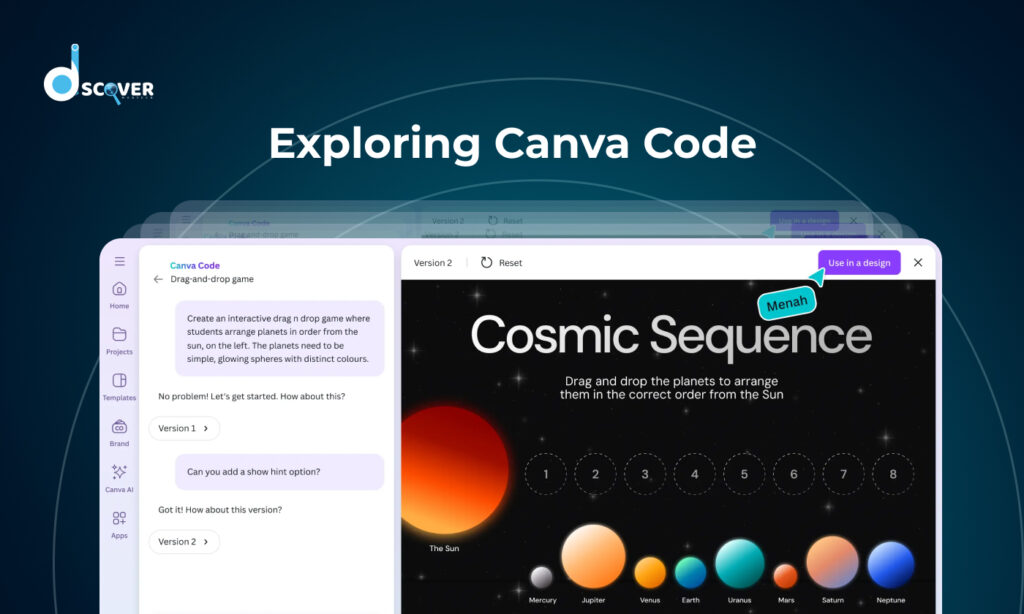
In the evolving landscape of digital design, the ability to create interactive content without extensive coding knowledge is becoming increasingly valuable. Canva Code, introduced in 2025, is a groundbreaking tool that empowers users to design interactive elements seamlessly within the Canva platform. Whether you’re a marketer, educator, or designer, Canva Code provides an accessible way to create engaging experiences without writing a single line of code.
What is Canva Code?
Canva Code is an AI-powered feature within Canva that allows users to generate interactive widgets and elements through simple text prompts. Whether you’re looking to create a mini-game, a pricing calculator, or an interactive map, Canva Code simplifies the process, eliminating the need for traditional coding.
By leveraging artificial intelligence, Canva makes it possible for anyone to create interactive content that can be embedded into websites, presentations, and more. The beauty of no-code interactive design is that you can generate sophisticated designs without having a deep understanding of programming languages. All you need is a creative idea and the ability to describe it in a text prompt.
Key Features of Canva Code
Canva Code stands out for its simplicity, power, and flexibility. Here are the key features that make it a game-changer in no-code interactive design.
1. No-Code Interactive Design
Canva Code enables users to build interactive experiences instantly—no coding required. By typing a description of the desired functionality, the AI generates the corresponding interactive element, which can be customized further within the Canva interface. This makes it perfect for beginners or anyone looking to enhance their digital content quickly.
Whether you’re creating interactive forms, quizzes, or product showcases, Canva Code removes the complexity associated with traditional web development and puts the power of interactive design into your hands.
2. Seamless Integration
The interactive elements created with Canva Code can be easily added to various designs, including websites, social media posts, and presentations, enhancing user engagement across platforms. Once the interactive element is generated, you can simply drag and drop it into your design workspace, just like any other Canva element.
This makes it incredibly easy for non-technical users to integrate interactive features into their existing content, boosting engagement and interactivity with minimal effort.
3. AI-Powered Customization
Leveraging AI, Canva Code offers suggestions and refinements to the generated code, allowing users to tailor the interactive elements to their specific needs without delving into complex programming. The AI adapts to your input, offering smart customization options to ensure your interactive elements are both functional and visually appealing.
This combination of AI and no-code interactive design makes Canva Code an essential tool for anyone looking to enhance their digital content and increase user interaction.
Getting Started with Canva Code
Ready to bring your ideas to life without writing a single line of code? Follow these simple steps to start using Canva Code and create interactive designs with ease.
Step 1: Access Canva Code
To get started with Canva Code, simply navigate to the Canva platform and select the ‘AI Code Generator’ feature. This will open the interface where you can begin creating your interactive elements.
Step 2: Input Your Prompt
Describe the interactive element you wish to create. For example, “Create a quiz to assess knowledge on digital marketing basics.” The AI will interpret your prompt and generate the corresponding interactive component. The more specific you are with your description, the more accurately the AI will generate the element you need.
Step 3: Customize the Element
Once the initial version is generated, you can customize the design, functionality, and content to align with your brand and objectives. You can tweak everything from the layout and colors to the interactions and behaviors, ensuring that the final product aligns perfectly with your vision.
Step 4: Integrate into Your Design
After customizing your interactive element, it’s time to integrate it into your existing design. Whether you’re working on a website, social media post, or presentation, Canva Code allows for seamless integration of your interactive element with just a few clicks.
Practical Applications of Canva Code
Canva Code isn’t just innovative—it’s incredibly versatile. Let’s explore how different industries and creators can use it to build impactful interactive content.
1. Educational Tools
Canva Code is a game-changer for educators looking to create engaging and interactive learning experiences. You can design quizzes, flashcards, and other interactive learning tools that enhance student participation and make the learning process more engaging. Interactive learning becomes more accessible, enabling you to create content that speaks to modern students’ preferences for interactive experiences.
2. Marketing Campaigns
For marketers, Canva Code provides an easy way to build interactive forms, surveys, and calculators that can be embedded into marketing campaigns. Interactive tools like ROI calculators or product recommendation quizzes can help collect valuable data from users while simultaneously engaging them with your brand.
Additionally, you can create dynamic call-to-action buttons or surveys that encourage users to interact with your campaign, improving customer engagement and conversion rates.
3. Event Planning
Event organizers can use Canva Code to design interactive schedules, maps, and agendas that can be shared with attendees. For example, creating an interactive event schedule allows attendees to filter by session or speaker, improving the overall experience. Interactive maps can help attendees navigate large conference halls or event venues with ease.
4. Product Showcases
For eCommerce businesses, Canva Code is an ideal solution for creating interactive product showcases. Instead of static images, you can add interactive product displays that allow users to view different product features, colors, or dimensions. This type of interactive product display can increase user interest and lead to higher conversion rates.
Advantages of Using Canva Code
Beyond ease of use, Canva Code offers several powerful benefits that make it a must-have tool for modern creators. Here’s what sets it apart.
- Efficiency: Rapid development of interactive elements without the need for coding expertise.
- Customization: Tailor-made interactive components that align with specific goals and branding.
- Integration: Seamless addition of interactive elements into various design formats within Canva.
- Accessibility: Empowers individuals without technical backgrounds to create dynamic content.
Key Benefits of No-Code Interactive Design
The no-code interactive design feature of Canva Code allows users to unlock their creativity without the need for any technical skills. This is perfect for those who want to create professional-grade interactive designs but do not have a background in coding.
Moreover, the ability to seamlessly integrate these elements into your existing content (e.g., websites, presentations, and marketing campaigns) enhances the overall user experience and drives higher engagement.
Final Thoughts
Canva Code is revolutionizing the way we approach interactive design. By combining AI with no-code interactive design, Canva is enabling creators of all backgrounds to build dynamic and engaging content. From educators to marketers, Canva Code offers something for everyone, empowering users to enhance their digital designs without needing technical expertise.
Whether you’re looking to create a quiz, a product showcase, or an event map, Canva Code makes the process easier, faster, and more accessible than ever before. Give it a try and start creating your own interactive designs today!
Contact us to know our services
Check out our latest blog on “The Role of Noindex Tags in WordPress SEO: A Simple Guide for Website Owners”


